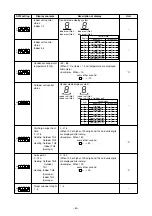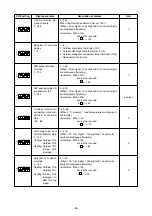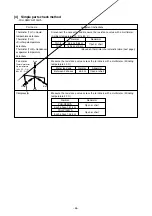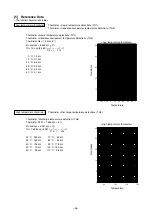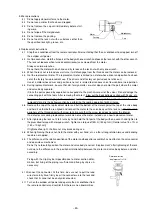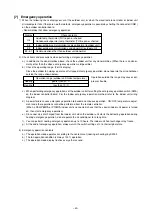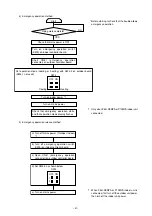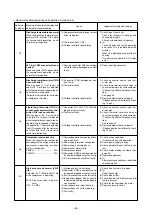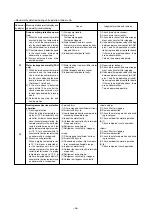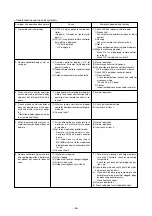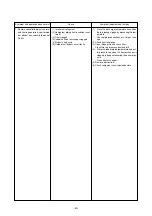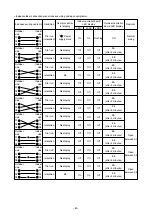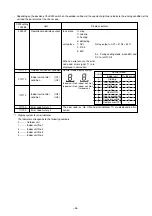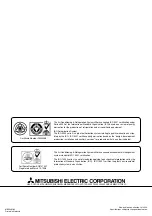
–45–
<Abnormality detected during unit operation: Indoor unit>
Abnormal-
ity display
P1
P2
P4
Meaning of abnormality display and
abnormality troubleshooting
Intake sensor abnormal
1) If thermistor open or short is de-
tected and the compressor enters
the 3 minutes restart prevention
mode and does not return to nor-
mal after 3 minutes, an abnormal-
ity is recognized.
(If returned, returns to normal op-
eration.)
2) Always detected during cool, dry,
and heat operations.
Short: 90
°
C or higher
Open: –40
°
C or lower
Piping sensor abnormal
1) If thermistor short or open is de-
tected and the compressor enters
the 3 minutes restart prevention
mode and does not return to nor-
mal after 3 minutes, an abnormal-
ity is recognized.
(If returned, returns to normal op-
eration.)
2) Always detected during cool, dry,
and heat (except during defrost-
ing) operation.
Short: 90
°
C or higher
Open: –40
°
C or lower
Drain sensor abnormal
1) If thermistor short or open continu-
ously detected for 30 seconds, the
compressor enters the check
mode and turns off and the indoor
fan turns off.
2) When another short or open is
continuously detected for 30 sec-
onds in the check mode, an ab-
normality is recognized.
(If returned, returns to normal op-
eration.)
3) Always detected during cool, dry,
and drain pump operation.
Short: 90
°
C or higher
Open: –20
°
C or lower
Cause
(1) Thermistor characteristics faulty.
(2) Connector contact faulty.
(Insertion faulty)
(3) Thermistor wiring open or contact
faulty.
(4) Indoor controller board faulty.
(1) Thermistor characteristics faulty.
(2) Connector contact faulty.
(Insertion faulty)
(3) Thermistor wiring open or contact
faulty.
(4) Faulty refrigerant circuit, etc. has
caused thermistor temperature to rise
to 90
°
C or higher or drop to –40
°
C
or lower.
(5) Indoor controller board faulty.
(1) Thermistor characteristics faulty.
(2) Connector contact faulty.
(Insertion faulty)
(3) Drain sensor wiring open or contact
faulty.
(4) Indoor controller board faulty.
Judgment method and remedy
(1)-(3)
Check thermistor resistance value
0
°
C ...... 15.0 k
Ω
10
°
C ........ 9.7 k
Ω
20
°
C ........ 6.4 k
Ω
30
°
C ........ 5.3 k
Ω
40
°
C ........ 3.1 k
Ω
Open or faulty contact can be detected
by applying force (pulling, bending) to
lead wire while measuring thermistor
resistance.
(2) Check for connector faulty contact.
After reinserting connector, turn on
power and recheck operation.
(4) Check remote controller room tempera-
ture display.
If there is a difference between actual
room temperature and displayed room
temperature after checking that there
are no problems at (1)-(3), replace in-
door controller board.
If there are no problems above, there
are no abnormalities.
Turn power off and on and operate.
(1)-(3)
Check thermistor resistance value.
For characteristic, see above (P1).
(2) Check for connector faulty contact.
After reinserting connector, turn on
power and recheck operation.
(4) Operate in trail run mode and check
piping temperature with remote control-
ler. When piping temperature is abnor-
mally low (cooling) or high (heating),
refrigerant circuit is probably faulty.
(5) Check test run mode piping tempera-
ture with remote controller.
If there is a difference between actual
piping temperature and displayed pip-
ing temperature when there are no ab-
normalities at (1)-(4), replace indoor
controller board. If there is no problem
above, there are no abnormalities.
Turn on power and operate.
(1)-(3)
Check thermistor resistance value.
0
°
C .... 6.0 k
Ω
10
°
C .... 3.9 k
Ω
20
°
C .... 2.6 k
Ω
30
°
C .... 1.8 k
Ω
40
°
C .... 1.3 k
Ω
(2) Check connector for faulty contact.
After reinserting connector, turn on
power and recheck operation.
(4) If abnormality reproduced by shorting
between drain sensor connector CN31
pins 1 and 2 and operating air condi-
tioner, replace indoor controller board.
If there are no problems above, there
are no abnormalities.
Turn on power and operate.


